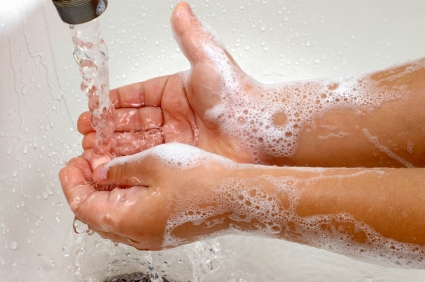The National Athletic Trainers' Association (NATA) has issued a position statement on preventing MRSA and other skin diseases among athletes at all levels, from youth to professionals. The statement, published in the July 2010 issue of the Journal of Athletic Training, was announced at the NATA's 61st Annual Meeting in Philadelphia and is available online. It includes comprehensive recommendations for the prevention, identification and treatment of fungal, viral and bacterial skin infections, some of which are life threatening. 
Facts about skin infections in athletics
- Skin diseases account for more than half (56 percent) of all infectious diseases in competitive sports from 1922 through 2005.
- Close quarters that promote skin-to-skin and bodily secretion contact make athletes particularly vulnerable to contracting skin diseases - some of which (e.g., MRSA) can be life threatening.
- Understanding basic preventive measures, identifying clinical features and swift management of skin diseases is essential in preventing the spread of common and serious skin infections.
Prevention guidelines for skin diseases
Steven M. Zinder, PhD, ATC, assistant professor of exercise and sport science at the University of North Carolina at Chapel Hill and chair of the position statement writing group said there are seven key guidelines for preventing the spread of skin diseases:
- Institutions must provide adequate financial and human resources to implement a comprehensive infectious disease control policy.
- Maintenance of clean facilities is paramount in limiting the spread of infectious diseases.
- Adequate hand hygiene including frequent hand washing and showering after every sport activity may be one of the biggest factors in reducing the spread of infectious diseases.

- Athletes and coaches must be educated about, and encouraged to follow, good overall hygiene practices.
- Athletes must be discouraged from sharing towels, athletic gear, water bottles, disposable razors and hair clippers.
- All clothing and equipment should be laundered and/or disinfected on a daily basis.
- Athletes should be encouraged to complete daily skin surveillance and report any suspicious lesions for treatment.
"The burden of skin diseases extends far beyond the financial toll for medical services and lost productivity," Zinder said. "We should concentrate our efforts on preventing these diseases rather than expending our resources attempting to treat them."
Education: first-line defense against skin diseases
Jack Foley, ATC, assistant athletic director and director of sports medicine, Lehigh University and part of the position statement writing group, believes that education is the fundamental first step in halting the spread of skin diseases. "It is necessary to have well informed personnel and athletes in order to promote our best line of defense against skin infection outbreaks," Foley said. "Putting a strategic plan in place, and using a team approach with the latest clinical knowledge available to us, is the absolute best insurance against skin infections in athletics."
David B. Vasily, MD, FAAD, team physician/dermatologist at Lehigh University, president of Lehigh Valley Dermatology Associates and writing group member, agreed with Foley that a preemptive, forward looking plan is also essential in preventing skin diseases among athletes and teams. "Until now the medical field has been by necessity focused on the reactive development of treatment regimens and drugs, rather than on prevention," Vasily said. "It's now clear that we need to re-focus our efforts in a more proactive and preventive way to achieve the greatest benefits."
Fighting spread of MRSA
There are three types of skin diseases: fungal (e.g., tinea pedis or athlete's foot); viral (e.g., herpes simplex or cold sores); and bacterial (e.g., staphylococcus a or impetigo). One of the most insidious, dangerous and even life-threatening bacterial skin diseases among athletes is the common antibiotic-resistant pathogen known as methicillin resistant staphylococcus aureus or MRSA, which has seen explosive growth in recent years. According to the U.S. Centers for Disease Control and Prevention (CDC), in 1974 MRSA accounted for just 2 percent of all infections; by 2004 MRSA accounted for 63 percent of all infections.
James J. Leyden, MD, FAAD, emeritus professor of dermatology at the University of Pennsylvania and position statement reviewer, believes it is crucial that athletes, coaches, parents and health care providers learn about MRSA, among other infectious diseases, as a major disease risk among athletes, because it can result in serious long-term illness or even death. "Everybody on the team and on the sidelines must follow infection control protocols, understand how MRSA spreads, and act in ways that will reduce the risk of contagion," Leyden said. "Careful decisions regarding the safe and effective use of antibiotics will help slow or halt the development of additional drug resistant strains of this very serious pathogen."
"There is nothing more important to coaches than the health and safety of their athletes," according to Mike Moyer, executive director of the National Wrestling Coaches Association. "Skin infections can not only sideline the athlete from play, but also cause removal from school classes and social activities. MRSA and other skin conditions can be passed along from athlete to athlete very quickly, sometimes with fatal consequences, so prevention and detection efforts aren't just nice to have. They're imperative."
Wrestler shares MRSA story
Kyle Frey, 21, a junior and wrestler at Drexel University, told of his personal battle with MRSA. What started as a small "pimple" grew to the size of his left bicep in just two days. He was diagnosed with MRSA, spent five days in the hospital in quarantine and was given antibiotic, to which he was initially resistant. He was then given a different set of antibiotics and had to have his arm surgically cleaned to control the infection. He continued taking antibiotics and had his arm stitched and bandaged so he could return to play.
"The whole experience taught me the importance of prevention and early treatment when it comes to skin infections," said Frey. "My athletic trainer, coach and doctors knew immediately what do to. My mom and teammates provided additional support and we are all much more aware of our personal hygiene in the locker room and with team equipment and mats."
Source: National Association of Athletic Trainers
Created June 22, 2010








